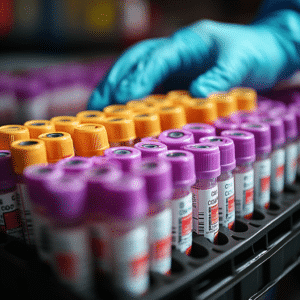Understanding How Long Does Ativan Stay In Your System
Understanding how long Ativan stays in your system is crucial for various reasons, especially for parents dealing with their children’s struggles with addiction. At Mothers Against Addiction, we recognize the power of knowledge in navigating these challenging waters. This article delves into the specifics of Ativan, its pharmacokinetics, potential for addiction, and detection times, aiming to equip you with comprehensive insights.
Ativan Half-Life and Its Implications
The concept of “half-life” is pivotal when considering how long a drug remains active in the body. For Ativan, also known by its generic name lorazepam, the half-life varies based on individual factors, generally averaging about 12-18 hours but can extend up to 24 hours in some cases.
- Pharmacokinetics of Ativan: Ativan’s journey in the body involves hepatic metabolism, followed by excretion through the kidneys. This process’s efficiency can be influenced by the functionality of the liver and kidneys. Understanding this half-life of Ativan helps us gauge how long it might affect the user.
- Comparative Analysis with Other Benzodiazepines: Comparing Ativan to other benzodiazepines offers perspective. Drugs like Diazepam (Valium) have a prolonged half-life of up to 48 hours, while Alprazolam (Xanax) has a shorter half-life, around 11 hours. This comparison shows where Ativan stands among its peers.

How Long Does Ativan Last in the Body?
Considering the duration of Ativan’s action is another vital aspect. The drug’s clinical effects, such as reducing anxiety or inducing sedation, typically last about 6-8 hours.
- Factors Affecting Duration: Age, weight, metabolism, and genetic factors can influence how long Ativan’s effects last. For example, older adults might process the drug more slowly due to reduced metabolic activity. Even your diet and overall health can play a part.
- Clinical Usage Scenarios: Ativan is often used for acute situations, like severe anxiety attacks or surgical procedures, providing rapid relief. However, its lasting presence can be troublesome, leading to prolonged side effects and risk of accumulation.
| Factor/Aspect | Description |
| Active Ingredient | Lorazepam |
| Detection in Urine | Up to 6 days; metabolites up to 9 days |
| Detection if Regularly Abused | Presence may be revealed for a week or longer |
| Peak Plasma Concentration | ~2 hours post-administration |
| Plasma Level (2 mg dose) | Approximately 20 ng/mL at peak concentration |
| Half-life of Lorazepam | ~12 hours |
| Half-life of Lorazepam Glucuronide | ~18 hours |
| Full Sedating Effect Duration | 6 to 8 hours |
| Common Side Effect | Daytime drowsiness/sleepiness |
| Usage Recommendation | Not recommended for use longer than 4 weeks |
| Effects on Brain and Nerves | Can cause rebound anxiety, sleep disturbances, abnormal body movements, and agitation |
| Safety Precautions | Avoid driving, riding a bike, or using machinery if feeling sleepy |
| GAO Detection Variability | Some benzodiazepines like alprazolam, clonazepam, temazepam, and triazolam may not show up in many standard urine tests |
How Long Does Ativan Stay in Your System: Testing and Detection
For those worried about drug testing, knowing how long Ativan stays in your system is vital. Ativan can be detected in various bodily fluids and tissues, offering different windows for discovery.

How Long Does Lorazepam Stay in Your System: Real-World Examples
Let’s look at some real-life examples highlighting how individual factors can influence how long lorazepam stays in your system.
Is Ativan Addictive?
The potential for addiction is a pivotal concern for parents, especially when it involves teenagers or young adults.
How to Mitigate Risks
Risk management is paramount when dealing with potential addiction issues.
Innovative Wrap-Up: Roles of Parents in Managing Ativan Use
As parents, being informed, vigilant, and proactive with medications like Ativan is critical. Equipped with the knowledge about the duration, detection, and risks of Ativan, you can make informed decisions, providing necessary support to your children.
By maintaining open communication, consulting professionals, and utilizing support networks, you can navigate these challenging territories. At Mothers Against Addiction, we stand by your side, helping you steer through the maze of addiction, ensuring healthier futures for your family.
For more insightful articles on topics like t h c liquid, How To smoke hash, and navigating complex addiction scenarios, visit Mothers Against Addiction. Empowerment begins with understanding, and together, we can make a difference.
Stay informed, stay vigilant, and most importantly, stay hopeful. Your actions and understanding can save lives and foster a healthier future for your loved ones.
How Long Does Ativan Stay in Your System
Understanding how long Ativan stays in your system can be crucial for various reasons, particularly for those dealing with addiction and their loved ones. Ativan (lorazepam) is a benzodiazepine, commonly prescribed for anxiety disorders, insomnia, and seizures. Generally, it can stay in the body for different durations based on numerous factors.
The Metabolism Myth
Did you know that Ativan’s half-life is usually around 12 hours, but it can vary? In some cases, it takes more than 24 hours for the body to eliminate just one dose. The specific amount of time how long Ativan stays in your system depends on factors such as metabolism, age, weight, and liver function. If you’re curious about metabolism factors, consider how substances like a thc Vape pen also influence the body’s processing time for various chemicals.
Factors You’re Forgetting
Interestingly, some people forget that their overall health can influence how long Ativan stays in your system. Regular users might notice that the body takes longer to detox, as benzodiazepines build up in the system over time. Similarly, body fat percentage plays a role, as Ativan is highly lipophilic, meaning it readily dissolves in fats. Just as characters in raise wa Tanin ga ii face unexpected twists, your unique physiology can lead to different timelines for detox.
Weird but True
Something many don’t think about is how hydration levels impact how long Ativan stays in your system. Being well-hydrated helps speed up the elimination process. Think of your body’s system like a mortgage: clear planning and management make a difference. Just as a monthly payment mortgage calculator helps you keep track of payments, staying hydrated helps flush out toxins.
Brainy Tidbits
Lastly, here’s a neat bit of trivia: other factors affecting how long Ativan stays in your system include diet and even genetic makeup. If you’re a fan of wider implications in scenarios, like those depicted in Agumon, understanding the science behind drug metabolism can mirror how characters navigate through complex worlds. One engaging Ted Talk why explored how individualized our bodies really are, emphasizing why everyone’s timeline can differ.
Understanding these factors is crucial for caregivers and those navigating the path of recovery, ensuring an informed approach and ultimately contributing to better health outcomes.

How long does lorazepam last after you take it?
Lorazepam generally has its full sedating effect for about 6 to 8 hours, but its metabolites can linger in your system and be detectable in urine for up to 9 days.
What is the peak life of Ativan?
The peak concentration of Ativan in the bloodstream happens about 2 hours after taking it, with a peak plasma level of approximately 20 ng/mL from a 2 mg dose.
Can Ativan make you feel bad the next day?
Yes, Ativan can make you feel bad the next day due to rebound effects like anxiety, sleep disturbances, and even agitation.
Does anxiety medication show up on drug tests?
Anxiety medication, particularly benzodiazepines like lorazepam, generally shows up on standard drug tests, although some specific types like alprazolam and clonazepam may not be detected in common tests.
Is .5 mg of Ativan a lot?
A dose of 0.5 mg of Ativan is considered low. It’s usually used for mild cases of anxiety or as a starting dose.
Is 2 mg of lorazepam strong?
A dose of 2 mg of lorazepam is on the higher side, especially for someone who isn’t used to benzodiazepines. It can be quite potent and is often used for more severe anxiety or specific medical procedures.
Is Ativan stronger than Xanax?
Ativan and Xanax are both benzodiazepines, but their effects can vary. Ativan is generally considered to last longer, while Xanax acts more quickly but wears off faster.
What is the maximum amount of Ativan in 24 hours?
The maximum recommended amount of Ativan in a 24-hour period varies but is typically capped at 10 mg to avoid overdose and serious side effects.
Can you take Ativan every day?
It’s generally not recommended to take Ativan every day for more than 4 weeks due to the risk of dependency and tolerance.
What is a good substitute for Ativan?
Alternatives to Ativan include other medications like buspirone or SSRIs, as well as non-drug approaches like cognitive behavioral therapy.
Why am I so tired the day after taking Ativan?
Feeling tired the day after taking Ativan is a common side effect due to its sedative properties that can linger into the following day.
What organ does lorazepam affect?
Lorazepam primarily affects the central nervous system, but it’s metabolized in the liver and can thereby impact liver function over long-term use.
Will lorazepam test positive for benzodiazepines?
Yes, lorazepam will test positive for benzodiazepines in a standard drug test.
How long do anti-anxiety meds take to wear off?
The active effects of anti-anxiety meds like lorazepam tend to wear off after 6 to 8 hours, though this can vary by dosage and individual metabolism.
What is the Rambo effect on Xanax?
“Rambo effect” on Xanax usually refers to a state of feeling overconfident or invincible after taking the medication, which can be risky.
How long is lorazepam active?
Lorazepam is active in the body for about 6 to 8 hours in terms of sedation, but its half-life is about 12 hours, meaning it takes this long for the level in the blood to reduce by half.
How far apart should you take lorazepam?
It’s best to follow your doctor’s advice on how far apart to take lorazepam, but common dosing intervals are every 6 to 8 hours to maintain a steady level in the bloodstream.
What will 1 mg of lorazepam do?
A 1 mg dose of lorazepam can help with anxiety, cause relaxation, and possibly induce sleepiness, depending on your tolerance and sensitivity to benzodiazepines.
Does lorazepam dissolve quickly?
Lorazepam tablets generally dissolve in the stomach, but there are also forms like oral solutions or sublingual tablets that dissolve more quickly.




























